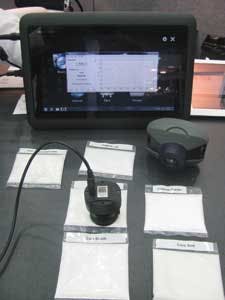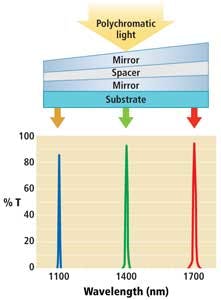Forensics: Near IR spectrometer targets handheld applications
Infrared spectroscopy is used for quantitative and qualitative analyses of solids, liquids, and gases in applications in food and agriculture, medical, pharmaceutical, and law enforcement applications. To record the infrared spectrum of a particular sample, it is first illuminated with light. Depending on the sample's molecular composition, energy will be absorbed at specific frequencies. Examining the wavelength spectrum of reflected light from the sample and comparing this with a known spectrum can then be used to identify the sample.
In the past, instruments to perform such tasks were large and expensive. In law enforcement applications, there is a demand to reduce the size and costs of such spectrometers so that they can be used to determine, for example, whether a suspect may be in possession of an illegal substance.
To accomplish this, JDSU Corporation (Milpitas, CA;www.jdsu.com/go/micronir) has leveraged the company's expertise in linear variable filters (LVFs) to develop a portable near-infrared (NIR) spectrometer that can measure diffuse reflection in the NIR region of the electromagnetic spectrum.
In the design of the miniature spectrometer, a thin film linearly variable filter is intentionally wedged in one direction such that a detected wavelength will be a function of the coating thickness. By bonding this LVF to a 128 × 1 InGaAs IR detector, reflected radiation in the 950-1650nm wavelength can be captured. Alternatively, an IR detector sensitive in other wavelengths such as the 1150-2150nm wavelength can be used. Each pixel of the detector will be sensitive to a specific wavelength. The LVF detector, light source, collection optics, and electronics are integrated in a palm-size device that weighs less than 60 grams and offered as a package to OEM customers.
In operation, two built-in tungsten lamps flood-illuminate a spot on approximately 3mm in diameter, at a 3mm distance from the spectrometer. The diffuse reflected radiation is detected at each pixel, read out over a USB interface and displayed on a computer. Alternatively, the spectrometer can be used in transmission mode where the light source is placed behind the sample to be analyzed. In this way, systems developers could build, for example, compact liquid analyzers. A demonstration of both reflective and transmission modes can be found at:http://bit.ly/18Q8D4B.
According to JDSU, although the optimal working distance of the spectrometer is approximately 3mm, longer working distances are also possible. Other spectral resolution levels can be attained through changing the number of pixels in the detector array or changing the design of the LVF.
To date, JDSU has demonstrated a handheld device that is interfaced to a portable computer or tablet via a USB interface.
Vision Systems Articles Archives


